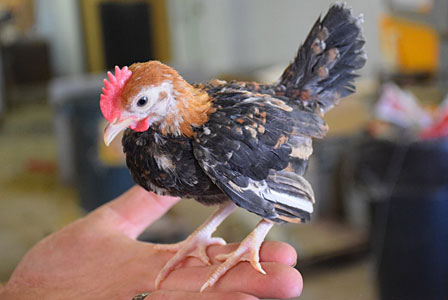
First, let’s establish that “bantam” is not a specific chicken breed. Rather, the word refers to a collection of breeds that are smaller than the usual egg-and-meat chicken breeds. A typical bantam weighs no more than two pounds, leading practical chicken keepers to wonder, “What’s the point?” Bantams don’t lay exceptionally well, and the eggs they do lay are quite small. Although the meat is tasty, what little of it there is, bantams are not economical to raise for meat. Nevertheless, here are 10 good reasons to keep bantam chickens.
1. Bantams Do Lay Eggs
Even though their eggs are quite small, most bantam hens lay at least as well as some of the larger chicken breeds. And the eggs are just as good, although you’ll need more of them. Since most recipes call for large chicken eggs, handy to know is how to convert egg sizes, whether for whole eggs or separated yolks and whites.
2. Bantams are Broody
Most bantam breeds tend to brood readily. In fact, a lot of people keep bantams specifically to incubate eggs of less broody breeds, rare breeds, and even non-chicken breeds. A bantam hen can successful incubate about 10 eggs of the size she lays. If the eggs she is expected to hatch are larger than her own, you’ll need to scale back the number to ensure she can cover them all.
3. Kids Love Bantams
Many bantam breeds tend to be naturally friendly, making them perfect for kids. And their smaller size and lighter weight render these diminutive chickens less intimidating and better suited for small folks to manage.
4. Bantams Need Less Space
For a yard with limited space for chickens, bantams are the answer. Full grown bantam chickens need only 2 square feet of coop space per bird, compared to 3 square feet for lightweight (layer) breeds and 4 square feet for heavy (meat) breeds. As with all chickens, the outdoor area should be as spacious as possible.
5. Bantams Eat Less
A mature bantam eats about 1/2 pound of ration per week. Compare that to an average of 2 pounds per week for a mature light breed, 3 pounds for a mid-weight dual purpose breed, and 4 pounds a week for a heavy breed. So one of the great reasons to keep bantam chickens is that they cost less to feed.
6. Bantams Poop Less
Because they eat less than the larger chicken breeds, bantam chickens poop less. That may be a disadvantage for someone who composts chicken bedding to fertilize a garden. But for many chicken keepers, poop disposal poses a problem that is significantly reduced by keeping bantams.
7. Bantams Make Great Pets
Since they require less space, eat less, and poop less, bantams are easier to care for than any of the larger breeds, so they make wonderful pets. That they are both good natured and easy keepers appeals to first-time chicken keepers who find bantams more user-friendly than the larger breeds.
8. Many Breeds and Varieties
Bantam breeds and varieties offer a huge selection to choose from. And anyone who can’t decide might opt for an assortment of purebred bantams, bantams with leg feathers or bantams without leg feathers.
9. Bantams Are Fun to Show
Some of the most popular chickens at poultry exhibitions are the purebred bantams. Their small size makes them easier to coop train, groom, and transport to shows. Among the most popular bantams for show are Cochin, Old English Game, and Silkie.
10. Bantams Are a Kick!
Bantams have huge personalities all out of proportion to their diminutive size. They are truly the characters of the poultry world, providing an endless source of entertainment. Right there, you don’t need any other reasons to keep bantam chickens.
More about Bantam Chickens
How to Care for Bantam Chicks Shipped By Mail
5 Bantam Breeds that Tolerate Warm Weather
11 Hardy Bantam Breeds for Cold Climates
And that’s today’s news from the Cackle Coop.
Gail Damerow is the author of Storey’s Guide to Raising Chickens.

